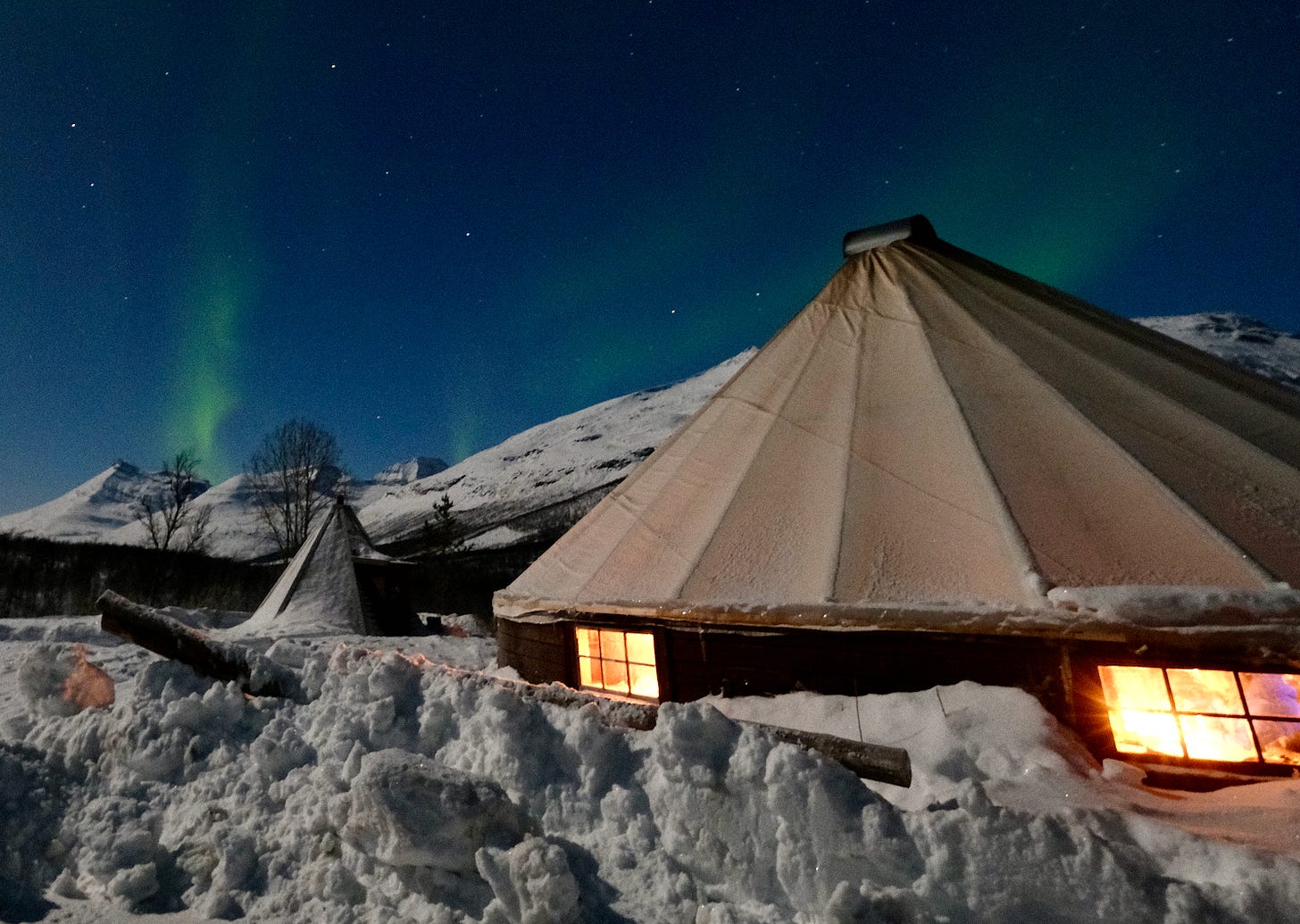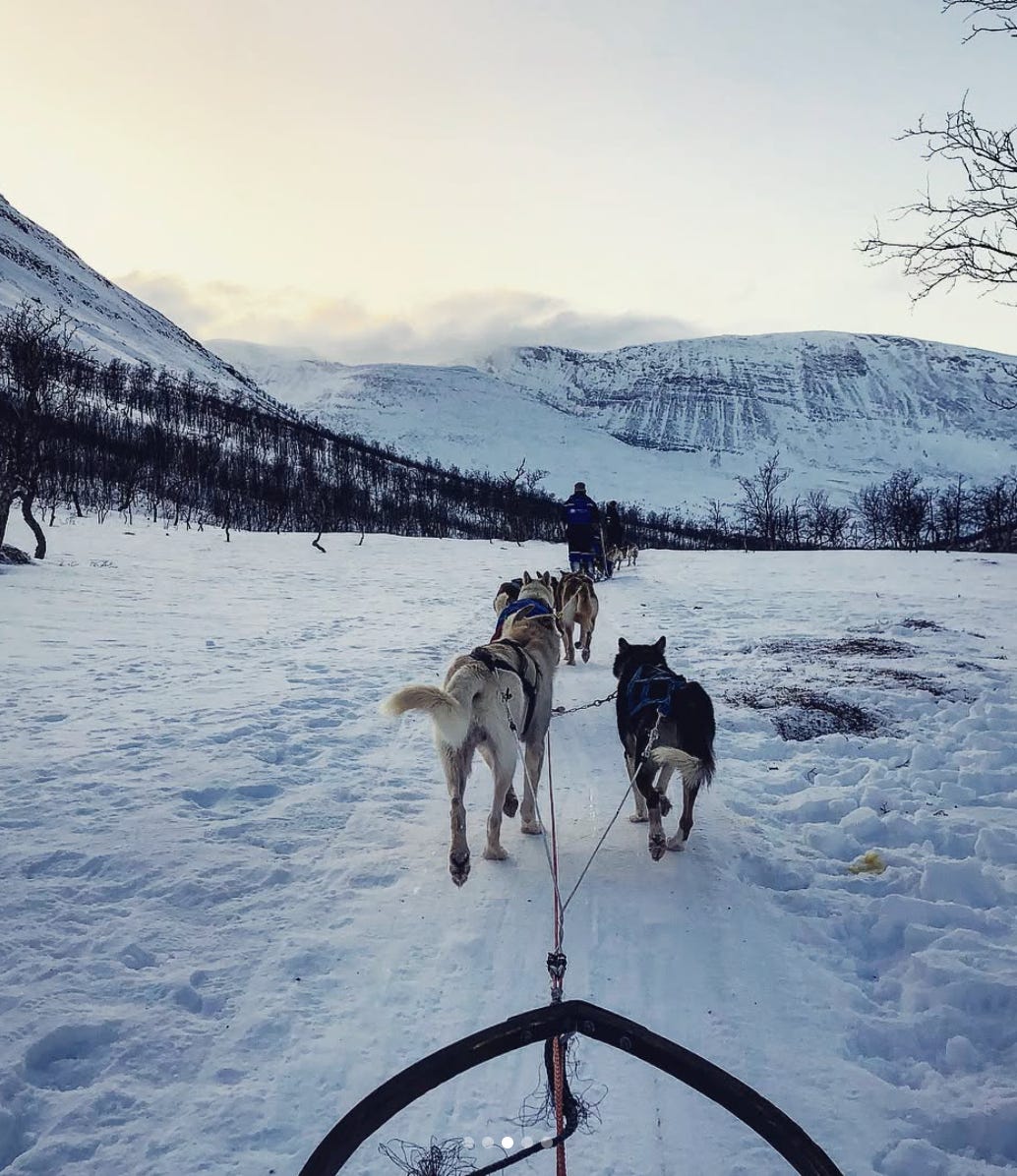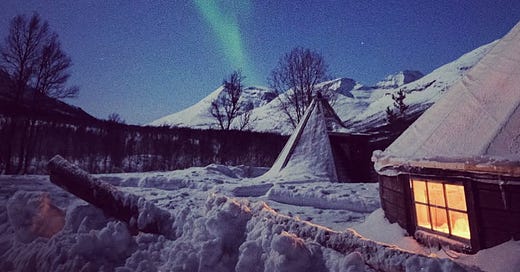A long night's journey into 'day'
The ultimate 'Northern Exposure' chasing the Aurora Borealis beyond Tromsø’s Arctic wilderness
The moment of crossing the Arctic Circle arrives without ceremony. Through the small aircraft window, the landscape below offers no visible boundary, no painted line across Norway's endless white expanse. Yet something shifts in the quality of light, in the consciousness of passengers glancing at GPS coordinates on seatback screens. We have entered a realm where human notions of habitability are challenged, where darkness and light engage in an ancient, uneven dialogue.

This invisible threshold marks more than geographic transition. It separates the comfortably familiar from a world governed by different laws—of temperature, of light, of time itself. We leave behind the Norway of fjords and fishing villages and enter a sparser, more elemental Norway. One where human presence feels more like a negotiation than a right.
The descent into darkness
Tromsø materialises from the twilight like a constellation fallen to earth. Its harbour lights shimmer against the encroaching darkness that, in January, never fully retreats. The sun hasn't risen here for weeks; won't rise for weeks more. What passes for daytime is a brief, blue-tinged gloaming—a few precious hours of half-light that locals savour with the appreciation of those who understand scarcity.
This ‘gateway to the Arctic’ exists in perfect liminality; a kind of threshold city poised at civilisation's edge. The "Paris of the North" (which is a bit of a stretch), wears this nickname with understated confidence, its wooden architecture suggesting European refinement transported to an improbable latitude.
The hotels understand their role as final waypoints before wilderness immersion. My stone-clad and triple-insulated glass edifice overlooking a harbour-side shipyard offered a calibrated introduction to Arctic living. Heated floors and thick duvets and warming whiskies create a cocoon that seems almost decadent against what waits beyond. At breakfast, travellers converse with the nervous energy of mountaineers before ascent; those who’ve returned share tales of glee or gloom as the fickle weather can thwart the best of viewing intentions.

Outside on the streets, locals move with the unhurried grace of those who've made peace with extreme conditions. In cafés, they must watch us insulated tourists with bemused tolerance: “Another layer," they might mutter sotto voce. "Always another layer than you think." Their relationship with cold isn't adversarial but philosophical: they perceive its nuances, and respect its boundaries.
In this way, the city feels like it has an important role to play for outsiders. A comforting, hospitable role, but without coddling; preparing without frightening. It offers a gradual transition rather than an abrupt threshold, allowing intrepid travellers to shed urban expectations incrementally. By the time we’re ready to depart for wilderness camps in the deep north, Tromsø has already begun a recalibration of sorts, shifting our relationship with light, with time, and with the very real prospect of standing on the edge of our cosmos.
We are a group of seven, from all corners of the globe, with almost 60 years between the youngest and oldest. Strange how questions around age surfaced so early with complete strangers. All decked out in various layers of merino and down, we pile into a sturdy assertive 4WD carrier van.
Before this, the guide who greets us checks our gear with the seriousness of one inspecting parachutes before a jump. "Your gloves," he says, frowning at someone’s inadequate designer pair intended for urban walks. From his pack comes thick mittens lined with what he calls "the only technology that matters this far north"—reindeer fur.
"These people," he says, meaning the Sámi who’ve inhabited these regions for millennia, "they solved cold long before Gore-Tex was invented."
The journey from Tromsø's harbour into the wilderness measures both distance and your relationship to civilisation. Each kilometre diminishes the ambient glow of human settlement, while deepening the feeling of extreme isolation until it becomes something palpable.
En route to the aurora camp, our guide suggests a detour to a frozen lake where time seems suspended in ice. "Fishing here isn't about catching," he explains as we follow his confident stride across the crystalline surface. "It's about listening to what happens beneath." Was he referring to the fish, the flowing water, or what? Fresh snow squeaks loudly under foot.
The guide brings the gear. The auger's spiral bit catches slivers of what passes for sunlight in this part of the world at this time of year as he demonstrates its use. It’s a tool unchanged for generations, he says. The sound it makes against ice is percussive. Each twist is a beat, sending powdered ice spiralling upward. The 40-50cm hole that emerges reveals an inky darkness.
We take turns with the twisting drill and drop our own lines into these individual portals, then arrange ourselves in patient constellation around them; our bums perched on tiny stools meant for kindergarten schools. A profound quiet settles. Gone are the perfunctory discussions around introductions. With no digital distractions, no conversation, there’s just breath condensing in air and the occasional shift of weight against creaking ice. Minutes stretch toward an hour.
“Got a bite yet?” are the only words uttered. Some said yes, but no Arctic Char or brown mullet took our bait. The enforced act of waiting in this grey brooding light transforms from an activity into a state of being, and you realise how rarely modern life permits this quality of sustained attention, this uncommented, unadorned presence and focus.
Into the wild
What passes for dusk doesn’t last long. We pack up and hit the road into the wild. Night comes quick. After what feels like a few hours on a main road we turn off onto an ill-defined track. There are no markers, no signs to show the way, except for landmarks and stars. But our guide seems to know where to go. Eventually we come to the camp. It’s in the bowels of a valley, from what I can tell, given the circling ridge of mountains etched in a stark silhouette against the inky, but star-spangled heavens. Those who prayed for a cloudless night take credit for the weather. Those of us who didn’t thank them too.
Camp is a collection of lavvu shelters. The lavvu represents Arctic ingenuity distilled to essential form: a rounded, conical shelter evolved through centuries of Sámi relationship with extreme environments. Traditional versions use wooden poles covered with reindeer hides, while our modern adaptations incorporate hardy canvas and hi-tech fabrics, all while honouring the original design principles.
This precisely engineered form sheds snow naturally, redirects harsh winds, and creates remarkable thermal efficiency. At its centre burns the hearth: both physical necessity and spiritual focal point, its smoke rising through an opening that connects inhabitants to sky and stars above.

Inside, the temperature rises to merely cold rather than unbearable. We gather in small groups; strangers becoming nervous companions through proximity and shared intent.
The interior space follows traditional organisation. The doorway typically faces south or southeast to avoid prevailing winds, while the area opposite (boaššu) holds sacred status. It’s an architecture born not from abstraction but direct environmental dialogue, and offers silent testimony that true sustainability emerges not from complexity but from generations of attentive presence to, and respect of, place.
Outside, in the distance, dogs bark. Our sleds are being readied. Lessons in steering and weight transfer and braking are patiently given. We split up into four convoys. We move in a single line but with what feels like a prehistoric rhythm. The sound of runners on snow creates another meditation (ice fishing being the earlier one), but here with an intense level of concentration that’s almost painful. This time, it’s a steady susurration punctuated by the breathing and barking of animals, one’s pounding heart beat, and the occasional command from mushers.

Existence narrows to the essential: Breath. Bracing cold. Balance. And keep a safe distance from the sled in front.
The vocabulary of ‘cold'
Cold intensifies away from the moderating influence of the coast. But it's difficult to convey extreme cold to those who haven't experienced it. Literary descriptions fall short. Numbers (-25°C) become abstract symbols divorced from physical reality. What does such cold actually mean? Add wind chill and the rush from locomotion across frozen ground and it’s likely closer to -35°C, according to the guide.
It means breath freezing in your nostrils with each inhalation. It means mucous gathering on your top lip quickly hardens. It means the sound of snow underfoot or under sled runners transforming from crunchy to a piercing squeak, to an almost metallic ring as moisture surrenders to crystallisation. It means discovering that eyelashes can freeze to eyebrows during a too-long gaze at stars.
Most significantly for photographers, it means fingers that cease to function as dexterous appendages. Camera controls designed for precision become impossible puzzles. The simple act of adjusting aperture or shutter speed requires removing layers of mittens, exposing skin to air that pulls warmth away with alarming efficiency, fumbling with suddenly alien dials, then retreating back into insulation as pain signals danger. Frost bite is real risk.
When the time came to stop, for there were ‘signs’ the skies were awakening, according to our guide, keener photographers than me starting unpacking camera bags.
Tripods and remote shutter releases were the order of the day. I had both but was unpracticed with their use. Your breath clouds the viewfinder, and freezes instantly. You wait for it to sublimate before vanishing without passing through a liquid state. An experienced trekker beside me said: "It's like deep-sea diving or space walking. The environment doesn't forgive carelessness."
A green genie released
The first hint comes as a smudge of green pulses into life barely distinguishable from cloud. The guide points, heads turn, voices hush, necks crane, eyes strain. Is this merely wishful thinking, a collective hallucination born of anticipation? But then movement confirms authenticity: a ripple, a flicker, a vertical stretching that transforms the smudge into something intentional.
What follows transcends expectation. The aurora doesn't simply appear; it unfurls, awakens, becomes. Like an absinthe-inspired green fairy released from earthly constraint, it begins to dance. The vertical streak extends, contracts, sends tendrils outward that sweep across the celestial dome. Colours intensify, fade, return with greater conviction. The entire display breathes with apparent consciousness, responding to forces invisible but clearly potent.

The silence among us transfixed observers feels ceremonial. Even those fumbling with cameras eventually surrender to direct witnessing. These northern lights on this cloudless night demand full and complete attention as this electromagnetic dialogue between sun and atmosphere is made visible and kinetic.
No photograph—regardless of technical perfection—captures the essential quality of this phenomenon: its movement. The aurora flows like illuminated liquid, swirls like luminescent smoke, dances like visible music.
Time becomes transcendental
How long did we stand gazing upward? Minutes stretch, contract, lose meaning. The ordinary markers of time—hunger, fatigue, even cold—recede before this dazzling display. Someone finally speaks, voice hushed with what sounds like reverence: "I never knew they moved like that … and the colours." The collective murmur of agreement feels like prayer.
Eventually, the lights begin their retreat, not disappearing suddenly but gradually diminishing, like a symphony's final movement rather than an abrupt conclusion. We remain rigid like statues, as if movement might call them back for an encore, or perhaps because we ourselves have forgotten how to move, temporarily transformed into creatures immobilised with unfettered fascination.
Return to earth
Dawn, or what passes for dawn this far north, imposes some philosophical thoughts. The return journey to Tromsø traverses the same physical distance but through an altered inner geography. The cold remains brutal, the darkness nearly absolute, but these conditions have been incorporated into an cosmological understanding of ‘place’ rather than merely endured.
The city's lights, which seemed so meagre upon arrival a few days earlier, now appear almost excessive, intrusive. We have adjusted to darkness rich with subtle variation, learned to perceive what exists beyond artificial illumination. This sensitivity makes the return to civilisation both comforting and vaguely, even weirdly disappointing.
Back at our hotel, removing layers feels like shedding an identity. Each thermal barrier peeled away brings me closer to my former self, yet something remains transformed, if only fleetingly. In the bathroom mirror, I still see a face flushed with cold's lingering embrace, but I see someone who has crossed more than a geographic or terrestrial threshold.
Later, reviewing photographs, I find them simultaneously miraculous and vastly inadequate. They show green streaks against star-scattered blackness, capture form but not essence. I guess the true aurora borealis exists not in pixels but in memory—kinetic, responsive, alive with mystery that crosses the boundary between scientific understanding and ancient wonder.
This journey into prolonged night reveals what we too rarely confront in our illuminated world: darkness is not empty but fertile; waiting is not wasted time but a necessary pilgrimage; cold is not merely absence of heat but presence of clarity. The northern lights themselves become a metaphor for revelation. Not permanently captured but briefly witnessed; not possessed but participated in.
In seeking aurora, we ultimately find something more valuable than spectacle. We discover how to be patient witnesses to phenomena that exist whether or not we are present to observe them. This humility—this recognition of our smallness against cosmic processes—may be the true gift of journeying beyond the Arctic Circle, into a long night that teaches us to see differently before delivering us, a little bit changed, into day.







